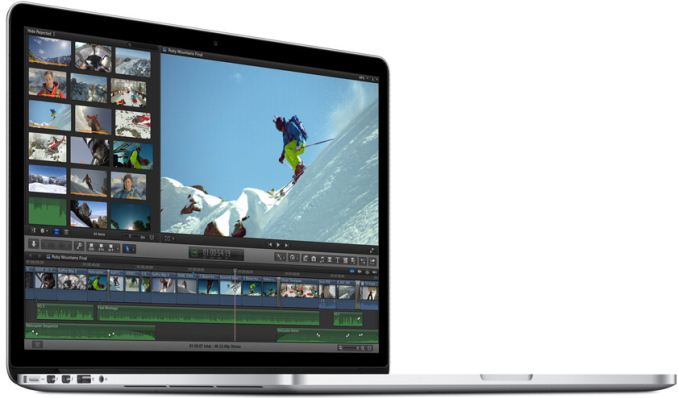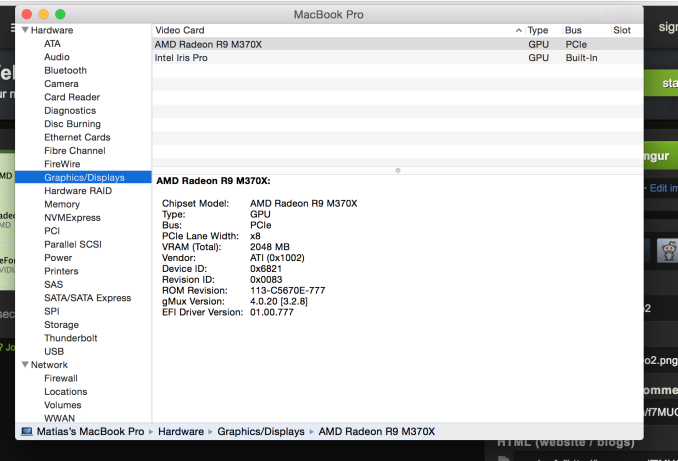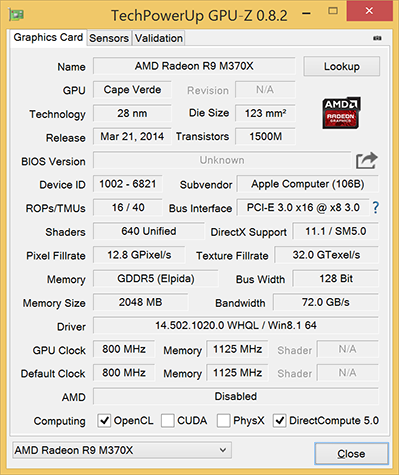2015 15-inch Retina MacBook Pro’s dGPU (R9 M370X) Is Cape Verde
by Ryan Smith on May 23, 2015 12:16 AM EST- Posted in
- GPUs
- Mac
- AMD
- Apple
- MacBook Pro
- Radeon
- Radeon 300

Earlier this week Apple announced their 2015 15” Retina MacBook Pro. Though Apple didn’t make any CPU changes, they did make some GPU changes on the high-end model, swapping out NVIDIA’s GeForce GT 750M for AMD’s Radeon R9 M370X. Since the M370X was not a published part number in AMD’s recently-announced 2015 Radeon M300 series refresh lineup, there have been some questions over just what M370X really is.
At the time of the rMBP’s launch, we suspected that it was an AMD Cape Verde GPU, based on the fact that this GPU is also in the M375, which is the next part above M370X. With the new laptop shipping immediately, M370X models have already begun arriving in buyers’ hands, finally giving us a chance to confirm the GPU inside.

Image courtesy Reddit user ootan
Thanks to Reddit user ootan, who posted a screenshot of the rMBP’s System Profiler, we can now confirm that the GPU in the rMBP is in fact AMD’s Cape Verde GPU. AMD has previously used the 6821 device ID on other mobile Cape Verde parts, so 6821 is already a known quantity.
| AMD M300 Series GPU Specification Comparison | |||||
| R9 M375 | R9 M370X (rMBP) | R7 M360 | |||
| Was | Variant of R9 M270/M260 | Variant of R9 M270X | Variant of R7 M270/M260 | ||
| Stream Processors | 640 | 640 | 384 | ||
| Texture Units | 40 | 40 | 24 | ||
| ROPs | 16 | 16 | 4? | ||
| Boost Clock | <=1015MHz | 800MHz | <=1015MHz | ||
| Memory Clock | 2.2GHz DDR3 | 4.5GHz GDDR5 | 2GHz DDR3 | ||
| Memory Bus Width | 128-bit | 128-bit | 64-bit | ||
| VRAM | <=4GB | 2GB | <=4GB | ||
| GPU | Cape Verde | Cape Verde | Oland/Topaz | ||
| Manufacturing Process | TSMC 28nm | TSMC 28nm | TSMC 28nm | ||
| Architecture | GCN 1.0 | GCN 1.0 | GCN 1.0 | ||
As for Cape Verde itself, as our regular readers may already know, it’s one of AMD’s first-generation GCN 1.0 GPUs, launched back in 2012. Compared to the GK107 GPU found in the GT 750M, it is a larger, more powerful (and at least in the desktop, more power-hungry) GPU, designed for more powerful devices than GK107 was. As for why Apple opted to switch now and to this GPU, we’ll leave that to Apple, AMD, and NVIDIA, though it’s by no means surprising that after having run GK107 for a couple of years, they would want to upgrade to a more powerful GPU.
Meanwhile, though we don’t have M370X on-hand at the moment, at least in the desktop, where GPU performance is unrestricted by thermals, Cape Verde fares very well. The rMBP on the other hand does have thermal constraints to deal with, so performance won’t be the same, but I expect it to fare reasonably well as well. Though at the same time I’m also curious if the use of a higher performance part has impacted the rMBP’s battery life when the dGPU is active; AMD and NVIDIA both do heavy binning, so a simple extrapolation won’t work here.
Update: And no sooner do I post this then someone sends me a screenshot of GPU-Z from a 15" rMBP running Boot Camp.
GPU-Z, for those unfamiliar with it, uses register poking to identify GPUs, so if the device ID wasn't enough, this settles it. This also confirms the clockspeeds - 800MHz core, 4.5GHz VRAM - and that the M370X is using GDDR5, unlike it's M375 counterpart. Thank you DMDrew812.
Source: Reddit User ootan (via SH SOTN)











107 Comments
View All Comments
ciparis - Saturday, May 23, 2015 - link
Please. Plenty of us know quite well exactly what we're getting for our money, in all categories. Whether the trade-offs feel worth it in this category, now that's the question.theSeb - Saturday, May 23, 2015 - link
That's a silly generalisation. Apple "fans" complain just as much, if not more, about some of these silly hardwre decisionsberniebennybernard - Saturday, May 23, 2015 - link
Considering how AMD has pretty much abandoned the mobile segment (aside from APUs), why Apple went with them instead of a more efficient and powerful Maxwell card such as the 950M makes completely no sense.mazzy80 - Saturday, May 23, 2015 - link
Upgrade now with the same Haswell CPU, a old GPU part, when in 2 months skylake will be out... makes no sense at all. Only to have the force-like touchpad ???Look like Apple has secured a good deep discount on Haswell and AMD GPU to further improve his margin....at the end of days you're paying $2.500 for a 2 years old mobile techs... that will overheat if pushed hard...
V900 - Saturday, May 23, 2015 - link
Sky lake most certainly won't be out in two months. Not for this form factor anyways. You probably won't see a Skylake Ultrabook till the end of the year.just4U - Monday, May 25, 2015 - link
What makes you think the 950 would be faster? If you look at the 960 and it's overall performance it's certainly not a must have.. and with the 950 a considerable step down from that I don't think it would be something that would blow this part away... infact far from it.. if you look at bench results of the 270X and 750ti.. the 950 might be comparable to that maybe..just4U - Monday, May 25, 2015 - link
oh wait a minute.. disregard that comment I guess.. this is mobile chips.. hum... but then wouldn't the 950 be a mobile variant as well?V900 - Saturday, May 23, 2015 - link
I love Apples products, have much of their lineup, and some may even call me a diehard Apple fanboy.But despite this, just like when they launched their anemic, port-challenged Retina MacBook, I can only say: WTF!?! Come on Apple, what the hell is the big idea here? It's a three year old GPU!
And Nvidia have one of their best lineups ever. The new generation of Maxwell GPUs would be awesome in the 15 inch MBP and would absolutely smoke the M370X.
Sure, AMD may have an advantage in Open CL, but Nvidia is no slouch there either. And CUDA has become a standard in itself in some industries.
repoman27 - Saturday, May 23, 2015 - link
Apple tends to stick with a chassis design for at least 4-5 years. With the Macbook Pro (Retina, 15-inch) they pretty much locked themselves into a certain TDP range for the dGPU (I'd reckon around 40-50 W) with the current chassis and cooling solution. If you look at GK107 and Cape Verde alongside the Maxwell options, you'll see that NVIDIA doesn't really offer anything that hits the sweet spot as far as price and/or TDP are concerned:GM108 = 1.02b transistors, 79 mm^2
GK107 = 1.27b transistors, 118 mm^2
Cape Verde = 1.5b transistors, 123 mm^2
GM107 = 1.87b transistors, 148 mm^2
GM206 = 2.94b transistors, 227 mm^2
That being said, I don't love that this is the 5th generation of MacBook Pro (Retina, 15-inch) to be based on Intel 22 nm CPUs paired with TSMC 28 nm GPUs. And if the rumor that Intel is shooting for a September-November 2015 launch window for Skylake-H is true, then it looks like they may have decided to cancel Broadwell-H entirely.
testbug00 - Saturday, May 23, 2015 - link
GM107 costs 20-25% more to make (depending on exact yields) or so. And uses less power. And is faster.Intel hasn't managed to make a chip over 150mm^2 on their 14nm process that is commercially buyable. Well, maybe some FPGA partner made a large one.... But, when you sell each chip for more than the wafer probably costs, yield doesn't matter nearly as much.